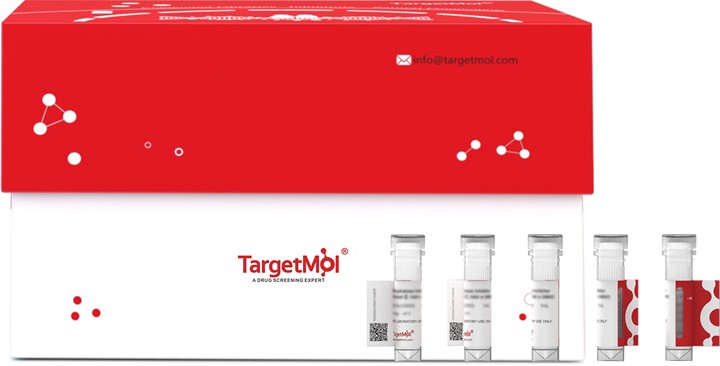 Your shopping cart is currently empty
Your shopping cart is currently empty
ADPRH Protein, Human, Recombinant (His)
Cholera toxin (CT) produced by Vibrio cholerae causes the devastating diarrhea of cholera by catalyzing the ADP-ribosylation of the alpha subunit of the intestinal Gs protein (Gsalpha), leading to characteristic water and electrolyte losses. Mammalian cells contain ADP-ribosyltransferases similar to CT and an ADP-ribosyl(arginine)protein hydrolase (ADPRH), which cleaves the ADP-ribose-(arginine)protein bond, regenerating native protein and completing an ADP-ribosylation cycle. CT-catalyzed ADP-ribosylation of cell proteins can be counteracted by ADPRH, which could function as a modifier gene in disease. Further, our study demonstrates that enzymatic cross talk exists between bacterial toxin ADP-ribosyltransferases and host ADP-ribosylation cycles. In disease, toxin-catalyzed ADP-ribosylation overwhelms this potential host defense system, resulting in persistence of ADP-ribosylation and intoxication of the cell. Mono-ADP-ribosylation is a reversible modification of proteins with NAD:arginine ADP-ribosyltransferases and ADP-ribosylarginine hydrolases (ADPRH) catalyzing the opposing arms of an ADP-ribosylation cycle. The ADPRH cDNA had been cloned from human, rat, and mouse tissues and high levels of mRNA were found in brain, spleen, and testis. Human ADP-ribosylhydrolase 1 (hARH1, ADPRH) cleaves the glycosidic bond of ADP-ribose attached to an Arg residue of a protein.

ADPRH Protein, Human, Recombinant (His)
| Pack Size | Price | USA Warehouse | Global Warehouse | Quantity |
|---|---|---|---|---|
| 5 μg | $79 | 7-10 days | 7-10 days | |
| 10 μg | $129 | 7-10 days | 7-10 days | |
| 20 μg | $208 | 7-10 days | 7-10 days | |
| 50 μg | $419 | 7-10 days | 7-10 days | |
| 100 μg | $812 | 7-10 days | 7-10 days |
Product Information
| Biological Activity | Activity testing is in progress. It is theoretically active, but we cannot guarantee it. If you require protein activity, we recommend choosing the eukaryotic expression version first. |
| Description | Cholera toxin (CT) produced by Vibrio cholerae causes the devastating diarrhea of cholera by catalyzing the ADP-ribosylation of the alpha subunit of the intestinal Gs protein (Gsalpha), leading to characteristic water and electrolyte losses. Mammalian cells contain ADP-ribosyltransferases similar to CT and an ADP-ribosyl(arginine)protein hydrolase (ADPRH), which cleaves the ADP-ribose-(arginine)protein bond, regenerating native protein and completing an ADP-ribosylation cycle. CT-catalyzed ADP-ribosylation of cell proteins can be counteracted by ADPRH, which could function as a modifier gene in disease. Further, our study demonstrates that enzymatic cross talk exists between bacterial toxin ADP-ribosyltransferases and host ADP-ribosylation cycles. In disease, toxin-catalyzed ADP-ribosylation overwhelms this potential host defense system, resulting in persistence of ADP-ribosylation and intoxication of the cell. Mono-ADP-ribosylation is a reversible modification of proteins with NAD:arginine ADP-ribosyltransferases and ADP-ribosylarginine hydrolases (ADPRH) catalyzing the opposing arms of an ADP-ribosylation cycle. The ADPRH cDNA had been cloned from human, rat, and mouse tissues and high levels of mRNA were found in brain, spleen, and testis. Human ADP-ribosylhydrolase 1 (hARH1, ADPRH) cleaves the glycosidic bond of ADP-ribose attached to an Arg residue of a protein. |
| Species | Human |
| Expression System | E. coli |
| Tag | N-His |
| Accession Number | P54922 |
| Synonyms | ARH1,ADP-ribosylarginine hydrolase |
| Construction | A DNA sequence encoding the human ADPRH (NP_001116.1) (Met1-Leu351) was expressed with a polyhistidine tag at the N-terminus. Predicted N terminal: His |
| Protein Purity | > 90 % as determined by SDS-PAGE |
| Molecular Weight | 41.7 kDa (predicted); 41 kDa (reducing conditions) |
| Endotoxin | Please contact us for more information. |
| Formulation | Lyophilized from a solution filtered through a 0.22 μm filter, containing PBS, pH 7.4. Typically, a mixture containing 5% to 8% trehalose, mannitol, and 0.01% Tween 80 is incorporated as a protective agent before lyophilization. |
| Reconstitution | A Certificate of Analysis (CoA) containing reconstitution instructions is included with the products. Please refer to the CoA for detailed information. |
| Stability & Storage | It is recommended to store recombinant proteins at -20°C to -80°C for future use. Lyophilized powders can be stably stored for over 12 months, while liquid products can be stored for 6-12 months at -80°C. For reconstituted protein solutions, the solution can be stored at -20°C to -80°C for at least 3 months. Please avoid multiple freeze-thaw cycles and store products in aliquots. |
| Shipping | In general, Lyophilized powders are shipping with blue ice. |
| Research Background | Cholera toxin (CT) produced by Vibrio cholerae causes the devastating diarrhea of cholera by catalyzing the ADP-ribosylation of the alpha subunit of the intestinal Gs protein (Gsalpha), leading to characteristic water and electrolyte losses. Mammalian cells contain ADP-ribosyltransferases similar to CT and an ADP-ribosyl(arginine)protein hydrolase (ADPRH), which cleaves the ADP-ribose-(arginine)protein bond, regenerating native protein and completing an ADP-ribosylation cycle. CT-catalyzed ADP-ribosylation of cell proteins can be counteracted by ADPRH, which could function as a modifier gene in disease. Further, our study demonstrates that enzymatic cross talk exists between bacterial toxin ADP-ribosyltransferases and host ADP-ribosylation cycles. In disease, toxin-catalyzed ADP-ribosylation overwhelms this potential host defense system, resulting in persistence of ADP-ribosylation and intoxication of the cell. Mono-ADP-ribosylation is a reversible modification of proteins with NAD:arginine ADP-ribosyltransferases and ADP-ribosylarginine hydrolases (ADPRH) catalyzing the opposing arms of an ADP-ribosylation cycle. The ADPRH cDNA had been cloned from human, rat, and mouse tissues and high levels of mRNA were found in brain, spleen, and testis. Human ADP-ribosylhydrolase 1 (hARH1, ADPRH) cleaves the glycosidic bond of ADP-ribose attached to an Arg residue of a protein. |
Dose Conversion
Calculator
Tech Support
| Size | Quantity | Unit Price | Amount | Operation |
|---|

Copyright © 2015-2025 TargetMol Chemicals Inc. All Rights Reserved.



